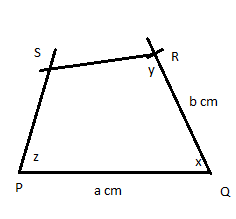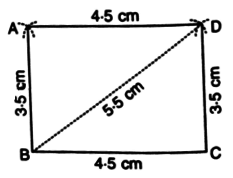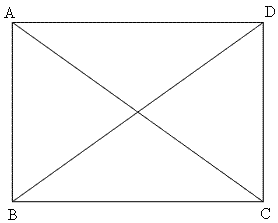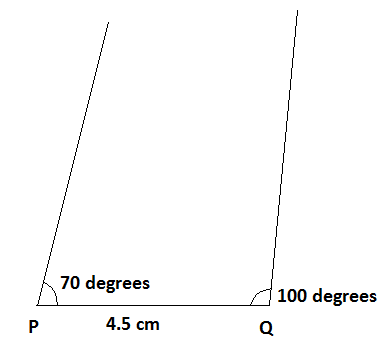8th Grade > Mathematics
PRACTICAL GEOMETRY MCQs
:
C
Suppose, we need to construct a triangle of whose two given sides are 'a' cm and 'b' cm and three given angles are x, y and z.

Step 1:Draw PQ= acm.
Step 2: Construct angle measuring x° at point Q.
Step 3: with Q as centre and radius equal to b cm cut an arc to meet at R.
Step 4: Construct an angle measuring y° at point R.
Step 5: Construct an angle measuring z° at P.
Step 6: The point of intersection of both thelines is the required point. Let this point beS.
Thus, fourth point is plotted using lines made by any two angles.
:
A
A quadrilateral is made up of two triangles. Diagonal is the common side for both the triangles. If all the four sides and a diagonal is known, then we can construct a quadrilateral by constructing two triangles. The two triangles are constructed using SSS property.
:
B
The given is 3 sides and 2 included angles
⟹ The angles are adjacent angles
Also their sum is75∘+105∘=180∘
⟹ Given angles are supplementary.
Then the remaining two angles are alsosupplementary. [∵ Sum of all the angles of a quadrilateral is 3600]
Hence, the quadrilateral is a trapezium as in a trapeziumadjacent angles are supplementary angles and since its given no sides are equal , it cannot be a parallelogram( opposite sides are equal) and square, rhombus( all sides are equal)
:
C
Suppose, we need to construct a triangle of whose two given sides are 'a' cm and 'b' cm and three given angles are x, y and z.

Step 1: Draw PQ = a cm.
Step 2: Construct angle measuring x° at point Q.
Step 3: with Q as centre and radius equal to b cm cut an arc to meet at R.
Step 4: Construct an angle measuring y° at point R.
Step 5: Construct an angle measuring z° at P.
Step 6: The point of intersection of both the lines is the required point. Let this point be S.
Thus, fourth point is plotted using lines made by any two angles.
:
B
The given is 3 sides and 2 included angles
⟹ The angles are adjacent angles
Also their sum is 75∘+105∘=180∘
⟹ Given angles are supplementary.
Then the remaining two angles are also supplementary. [∵ Sum of all the angles of a quadrilateral is 3600]
Hence, the quadrilateral is a trapezium as in a trapezium adjacent angles are supplementary angles and since its given no sides are equal , it cannot be a parallelogram( opposite sides are equal) and square, rhombus( all sides are equal)



















